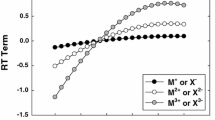Abstract
The possibility of determining the content of dissolved oxygen (O2) in distilled water, sea water, and aqueous solutions of electrolytes with errors of ∼2% without preliminary instrument calibration was demonstrated. The reasons for different relaxation efficiency coefficients reported by various authors were analyzed. The results of the determination of the content of O2 from the rate of spin-lattice relaxation in sea water and separate solutions of sea water components at 25°C depending on water salinity (S) up to 180‰ inclusive are presented. Noticeable changes in the steepness of the dependence of the content of O2 on S at 80–90‰ were observed; these changes were related to the attainment of the boundaries of the complete solvation of the main sea water ions. The main reasons for the discrepancies between the oxygen salting out coefficients K S found by various authors were explained, and the interrelation between the solubility of O2 and ion hydration characteristics was revealed. The O2 salting out constants for sea water and solutions of slats contained in sea water obtained from relaxation measurement data are given. The filling of “ice-like formation” voids was shown to be the main mechanism of the solution of O2 in water and aqueous solutions of electrolytes.
Similar content being viewed by others
References
E. I. Konnik, Usp. Khim. 46(6), 1097 (1977).
E. Wilhelm, R. Battino, and R. Wilcock, Chem. Rev. 77(2), 219 (1977).
R. Battino, T. R. Rettich, and T. Tominaga, J. Phys. Chem. Ref. Data 12(2), 163 (1983).
A. Sh. Groisman and N. E. Khomutov, Usp. Khim. 59, 1217 (1990).
Yu. G. Bushuev, N. V. Lomyga, and N. M. Zheleznyak, Zh. Obshch. Khim., No. 11, 1674 (1994).
H. E. Garcia and L. I. Gordon, Limnol. Oceanogr. 37(6), 1307 (1992).
E. Gnaiger, Mitochondrial Physiology Network 6(3), 1 (2001–2006).
J. E. Serwood, F. Stagniti, M. J. Kokkin, and W. D. Williams, Limnol. Oceanogr., p. 235 (1991).
R. S. Hamme and S. E. Emerson, Deep-Sea Res. 11, 1517 (2004).
F. J. Millero, F. Huang, and B. Graham, J. Solution Chem. 32(6), 473 (2003).
S. Emerson, S. Stump, D. Wilbur, and P. Quay, Mar. Chem. 64, 337 (1999).
H. N. Rasmussen and U. F. Rasmussen, Anal. Biochem. 319, 105 (2003).
B. B. Benson, D. I. Krause, and M. A. Peterson, J. Solution Chem. 8(9), 662 (1979).
A. A. Popel’, Magnetic Relaxation Method for Analysis of Substances (Khimiya, Moscow, 1978) [in Russian].
N. A. Mel’nichenko and V. I. Chizhik, Okeanologiya 22(2), 220 (1982).
R. A. Horne, Marine Chemistry: The Structure of Water and the Chemistry of the Hydrosphere (Wiley-Interscience, New York, 1969; Mir, Moscow, 1972).
A. F. Borina and O. Ya. Samoilov, Zh. Strukt. Khim. 15(3), 395 (1974).
V. K. Abrosimov, L. S. Efremova, E. V. Ivanov, and Yu. P. Pankratov, Zh. Fiz. Khim. 74(5), 854 (2000) [Russ. J. Phys. Chem. 74 (5), 752 (2000)].
D. S. Parker and J. Harmon, J. Chem. Phys. Letters 25(4), 505 (1974).
A. Lösche, Kerninduktion (Deutscher Verlag der Wissenschaften, Berlin, 1957; Inostrannaya Literatura, Moscow, 1963).
G. N. Zatsepina, Structure and Properties of Water (Mosk. Gos. Univ., Moscow, 1974) [in Russian].
J. S. Hidman, J. Chem. Phys. 60(11), 4488 (1974).
G. G. Malenkov, Zh. Strukt. Khim. 4(6), 5 (2006).
R. Hausser and E. Noack, Z. Naturforsch., A: Physc. Sci. 20(12), 1668 (1965).
M. E. Mirkej, Can. J. Chem. 43(5), 1130 (1965).
A. A. Vashman and I. S. Pronin, Nuclear Magnetic Relaxation and Its Application in Chemical Physics (Nauka, Moscow, 1979) [in Russian].
B. G. Emets, Zh. Tekh. Fiz. 70(1), 134 (2000) [Tech. Phys. 70 (1), 132 (2000)].
G. Chiarotti, G. Gristiani, and L. Giulotto, Nuovo Cimento 1(5), 863 (1956).
J. S. Hidman, A. Svirmickas, and M. Wood, J. Chem. Phys. 59(3), 1517 (1973).
N. A. Mel’nichenko and V. I. Chizhik, Zh. Strukt. Khim. 22(5), 76 (1981).
R. F. Weiss, Deep-Sea Res. 17, 721 (1970).
Oceanographic Tables: State Oceanographic Institute (Gidrometeozidat, Leningrad, 1975) [in Russian].
N. A. Mel’nichenko, Nuclear Magnetic Relaxation in Marine Water and Aqueous Solutions of Electrolytes (Dal’nevost. Gos. Univ., Vladivostok, 2002) [in Russian].
N. A. Mel’nichenko, Zh. Strukt. Khim. 48(3), 509 (2007).
N. E. Khomutov and E. I. Konnik, Zh. Fiz. Khim. 48(3), 620 (1974).
S. L. Clegg and P. Brimlecomle, Geochim. Cosmochim. Acta 54, 3315 (1990).
N. A. Mel’nichenko, A. M. Koltunov, A. S. Vyskrebentsev, and A. V. Bazhanov, Zh. Fiz. Khim. 82(5), 752 (2008).
Author information
Authors and Affiliations
Corresponding author
Additional information
Original Russian Text © N.A. Mel’nichenko, 2008, published in Zhurnal Fizicheskoi Khimii, 2008, Vol. 82, No. 9, pp. 1721–1728.
Rights and permissions
About this article
Cite this article
Mel’nichenko, N.A. The solubility of oxygen in sea water and solutions of electrolytes according to the pulse proton NMR data. Russ. J. Phys. Chem. 82, 1533–1539 (2008). https://doi.org/10.1134/S0036024408090239
Received:
Published:
Issue Date:
DOI: https://doi.org/10.1134/S0036024408090239



